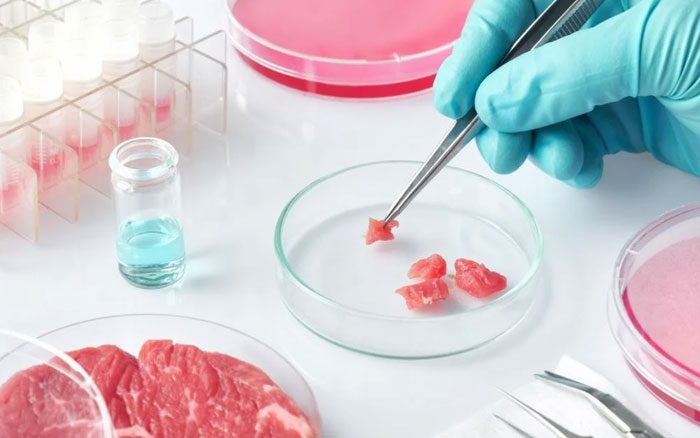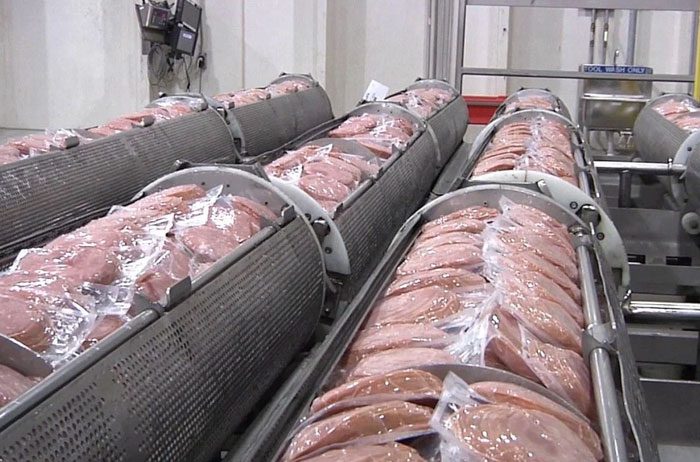Lab-grown meat can have a quality similar to real beef, but there are still some issues related to pricing, food safety standards, and community perceptions regarding the use of this product.
At the 27th United Nations Climate Change Conference (COP27), the Singapore government treated VIP guests to lab-grown meat, which is lab-cultured chicken approved by the Food Agency. The emergence of this type of meat marks a significant global milestone aimed at protecting biodiversity and forces us to rethink our methods of producing beef, pork, chicken, and seafood.
Supporters argue that lab-cultured meat helps reduce agricultural emissions and protects biodiversity. Conversely, opponents are concerned about high meat prices, along with legal barriers and the scalability of this meat industry.

Lab-grown meat helps reduce agricultural emissions. (Illustrative image).
Here are the key points we need to know about the current state and potential development of lab-grown meat.
What is Lab-Grown Meat?
Lab-grown meat is produced from animal stem cells cultured in a laboratory. These stem cells are “nurtured” from nutrients in a sterile bioreactor, forming lab-grown meat that consumers can consume.
For example, fish stomach. In many Asian countries, fish bladder is a delicacy. To create fish stomach in the lab, scientists from Avant Meats, based in Hong Kong, cultured fish cells in an environment containing dozens of different nutrients and stored them in a bioreactor with oxygen. Within a few weeks, these cells proliferate into tissues the size of rice grains and continue to grow larger.
The science of lab-grown meat is not new—cell culture was first used in medical research in 1907. However, applying the same to meat began to attract attention after a Dutch pharmacologist showcased a lab-cultured hamburger on television in 2013.
Today, over 100 companies around the world are striving to create cell-based proteins, from lab-grown lamb to lab-cultured oysters and even lab-grown foie gras.

Currently, over 100 companies worldwide are working to create cell-based proteins.
Difference Between Lab-Grown Meat and “Plant-Based” Meat
“Plant-based” meat refers to types of “meat” made from soy or containing non-animal-derived ingredients. Among the well-known companies in the plant-based meat sector, Impossible Foods and Beyond Meat are the most recognized names.
In contrast, lab-grown meat is produced by culturing animal cells directly. This type of meat also contains similar nutrients to regular beef, pork, poultry, and seafood. Overall, both plant-based meat and lab-grown meat (or cell-cultured meat) aim to achieve similar flavor and texture.
According to estimates from the non-profit Good Food Institute Asia Pacific (GFI APAC), plant-based meat is still struggling to compete on price with conventional meat—holding less than 1% of the global market. However, this type of meat is still sold in many restaurants and grocery stores worldwide.

Legal barriers surrounding lab-grown meat still exist. (Illustrative image).
Currently, only Singapore allows the legal sale of lab-grown meat. This nation of 5.5 million people is focusing on reducing its reliance on imported food.
Industry monitors say that scaling up the production of lab-grown protein from trial stages to commercial levels requires significant technological advancements. Meanwhile, the massive bioreactors needed for mass production have yet to be constructed.
Additionally, legal barriers surrounding lab-grown meat still persist. In the United States, the Food and Drug Administration recently communicated with Upside Foods that they no longer doubt the safety of cell-cultured chicken for human consumption. However, this California-based food tech company still requires further approvals, including from the U.S. Department of Agriculture, the agency overseeing the market introduction of lab-grown meat.
Elsewhere, policymakers in China, Israel, and the Netherlands have signaled support for lab-grown meat from stem cells, but no agency has approved commercial trade of this type of meat.
Is Lab-Grown Meat Suitable for Vegetarians?
Technically, lab-grown meat is not vegetarian because it is created from growing cells taken from real animals.
Many choose vegetarianism for various reasons. They may be concerned about animal rights or the use of antibiotics and hormones in animal farming. Many others opt to avoid meat to prevent the depletion of environmental resources. For these reasons, cell-based meat could be a viable alternative.
Environmental Impact of Lab-Grown Meat
Cell-cultured meat plays an essential role in restoring biodiversity, which has long been threatened by traditional agriculture. A prime example is that about 80% of deforestation in the Amazon is attributed to expanding land for cattle grazing.
Compared to traditional farming, culturing meat from cells in bioreactors uses less land and reduces environmental emissions. If meat is produced this way, companies could build factories closer to consumers, helping to reduce the fuel needed for food transportation.

Cell-cultured meat plays a vital role in restoring biodiversity.
However, producing meat in bioreactors consumes a significant amount of electricity. According to a 2021 study by the Dutch environmental consulting firm CE Delft, if the production of lab-grown pork and chicken in bioreactors uses energy from wind, solar, and other renewable sources, it could be a feasible option to help reduce emissions.
Similar research indicates that cell-cultured beef would be more environmentally friendly than regular beef, as raising livestock consumes many resources.
Challenges Related to Lab-Grown Meat
Most concerns regarding lab-grown meat relate to its limitations: so far, the production of lab-grown protein remains expensive, making widespread market distribution— even with regulatory approval—difficult to imagine in the near future.
Nearly a decade after the world’s first lab-grown burger was created at a cost of $325,000, the only lab-grown meat sold in small quantities is in Singapore and produced by Eat Just. This company specializes in producing meat and egg alternatives and is based in San Francisco. They claim it will take 8 years for their products to compete on price with conventional meat.
Transparency is also a controversial aspect. Jaydee Hanson, policy director at the Washington-based non-profit Center for Food Safety, states that lab-grown protein producers rarely disclose how they maintain developing cells. This sometimes raises concerns about the “ethical” aspects of production, such as the use of fetal bovine serum as a cell culture medium.
Additionally, crucial factors such as appearance, texture, and flavor are also challenges for lab-grown meat to completely replace conventional meats.
















































